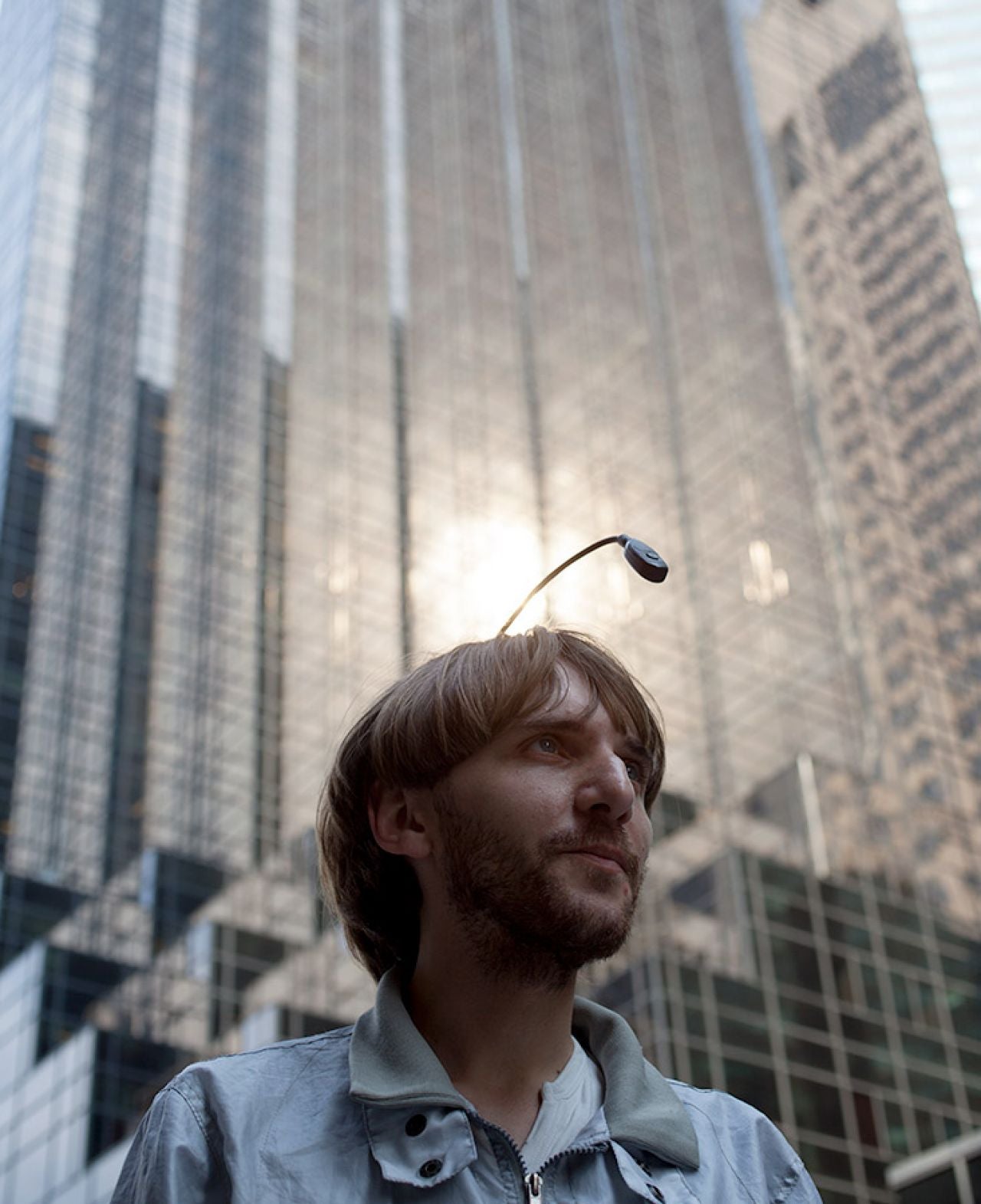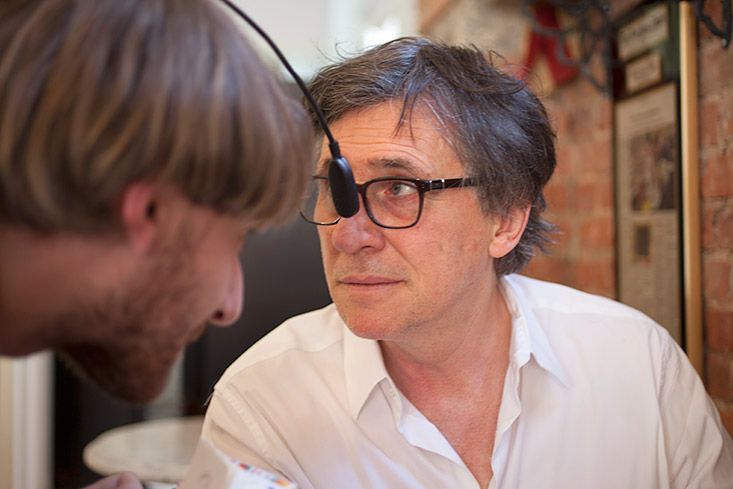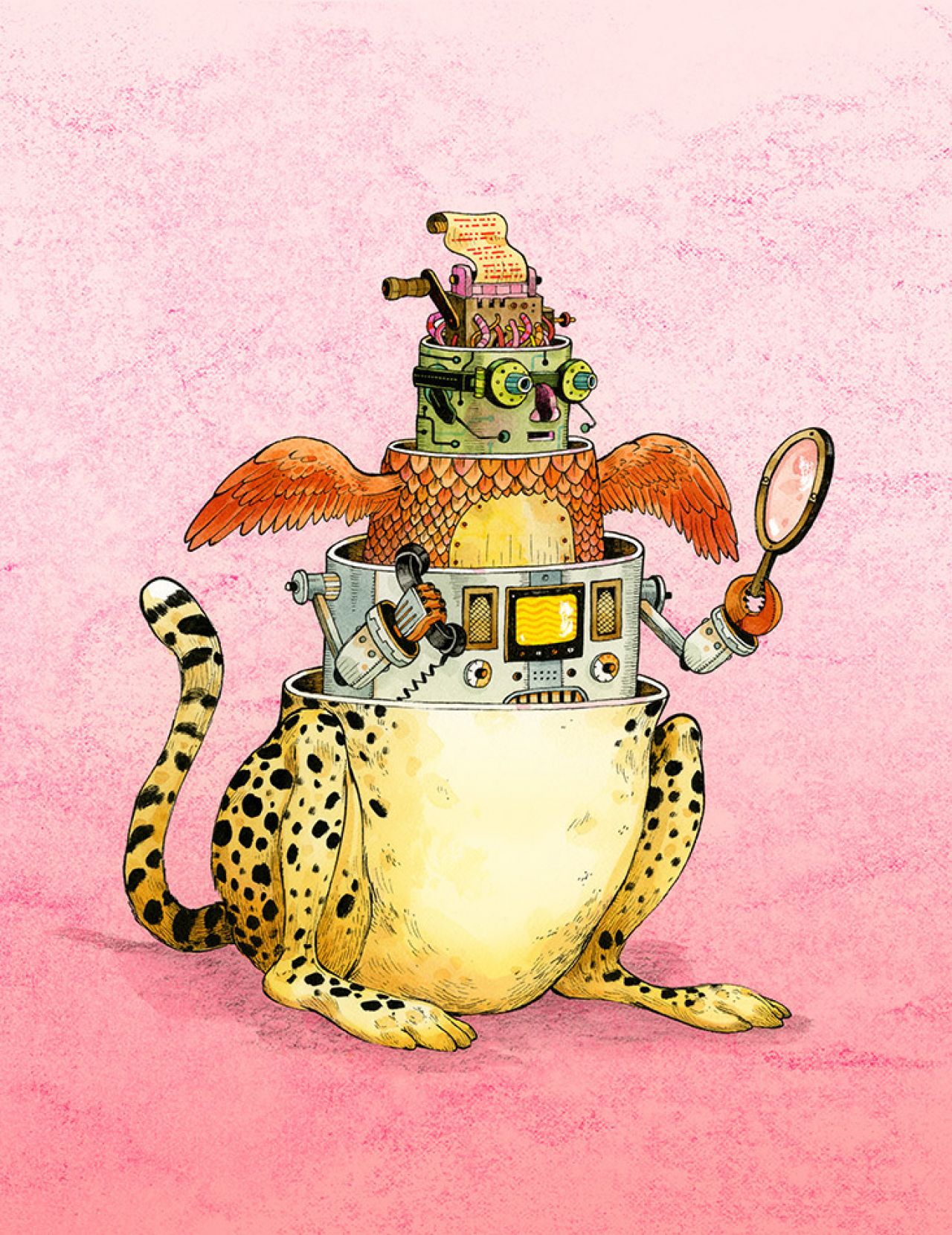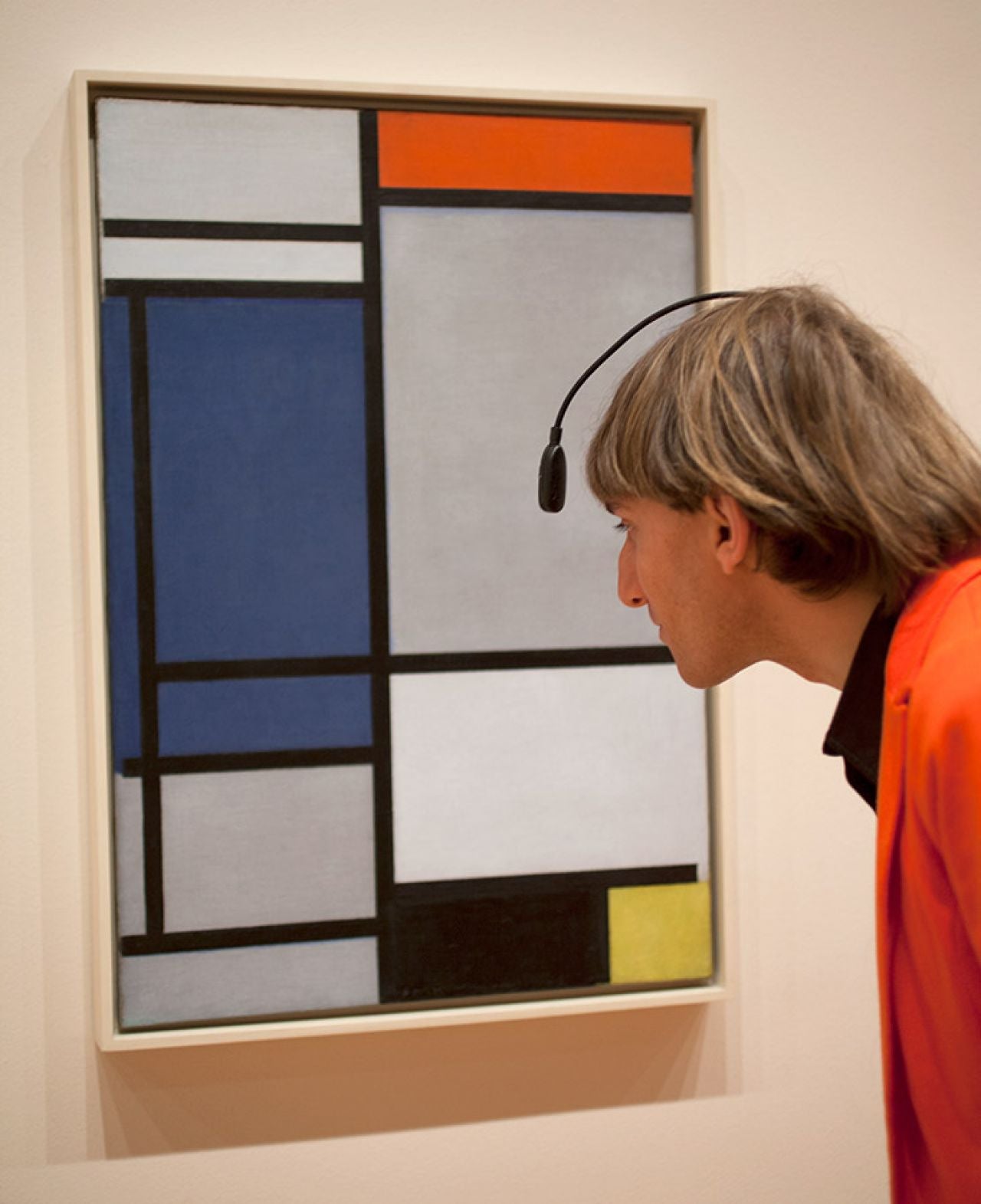On the second balmy day of the year in New York, Neil Harbisson, a Catalan artist, musician, and self-professed “cyborg,” walked into a café in the Nolita district of Manhattan. The actor Gabriel Byrne was sitting at a table in the corner. Harbisson approached. “May I do a sound portrait of you? It will just take one minute. For nine years, I’ve been listening to colors,” he explained.
Byrne eyed his questioner from under raised eyebrows. On a slight frame, the 30-year-old Harbisson wore a white T-shirt, deep-pink jeans and black-and-white showman’s brogues. His face was angular, with an aquiline nose and a chin smudged with grown-out stubble. A small plastic oval floated in front of his forehead, attached to the end of a flexible stem that reached around from the back of his head and over a sandy pageboy mop, like the light on the head of an angler fish. This “eyeborg,” as Harbisson calls it, converts light into audible sound, with a pitch that varies according to the color of the light.

With a good-natured shrug, Byrne relented. Harbisson darted down next to his quarry, intent, but with a boyish smile that betrayed his excitement. He pointed the eyeborg first at Byrne’s ear, then his lips, then his left eye, then the bridge of his nose, and finally his salt-and-pepper hair, scribbling down musical notes on the back of a cardboard coffee-holder. Byrne gave him his agent’s email. When Harbisson got back to a computer, he would make a sound file that combined the notes from each bit of Byrne’s anatomy, and send it back to the actor. Harbisson’s collection already included Prince Charles, Nicole Kidman, and Al Gore.
Harbisson sees the world in greyscale. Born in Belfast and raised in Catalonia in northeastern Spain, as a child Harbisson was diagnosed with achromatopsia, a rare congenital condition in which his eyes’ cone cells do not pick up color. He has worn a version of his eyeborg since 2004. It transposes color into a continuous electronic beep, exploiting the fact that both light and sound are made up of waves of various frequencies. Red, at the bottom of the visual spectrum and with the lowest frequency, sounds the lowest, and violet, at the top, sounds highest. A chip at the back of Harbisson’s head performs the necessary computations, and a pressure-pad allows color-related sound to be conducted to Harbisson’s inner ear through the vibration of his skull, leaving his outer ears free for normal noise. Harbisson, who has perfect pitch, has learned to link these notes back to the colors that produced them. Where once he had to rely on other people’s descriptions of how colors looked and what they meant, now he can create his own web of meanings and associations. He even hears sound-color in his dreams.
Harbisson never takes his eyeborg off, even to sleep or shower. The device, he said, “is part of my body.” This year, he plans to have it “osteointegrated,” inserted into the bone in his skull. It is his feeling of oneness with a qualitatively new sense, rather than the expansion of the sensorium itself, that makes him feel like a cyborg—a word, he noted, that was coined in 1960 as a contraction of “cybernetic organism,” in order to describe how astronauts could use drugs and devices to adapt their bodies for space travel. “If we can adapt ourselves to better live in space,” he told me, “why can’t we adapt ourselves to better live in nature?”
At least since Aristotle, Western cultures have defined the people that comprise them by drawing a line between humans and machines on the one hand, and humans and other living things, such as plants and animals, on the other. “It needs twenty years to lead man from the plant state in which he is within his mother’s womb, and the pure animal state which is the lot of his early childhood,” wrote Voltaire, “to the state when the maturity of the reason begins to appear.”
Since having his eyeborg fitted, Harbisson has been thrown out of churches and department stores.
Now, however, advances in artificial intelligence, cybernetics, and genomics are blurring the outlines of the once-cozy categories of human, animal, and machine. Under the loose and shifting rubrics of “transhumanism” and “posthumanism,” a growing number of artists, philosophers, and self-modifying “biohackers” are looking to redefine the boundaries of the self.
Such innovations cast doubt on the legitimacy of the distinctions we have used to frame ourselves for centuries. To argue for or against human uniqueness, one must first claim that we can know what makes us us, our quiddity. But if science suggests that there is no such thing, then human uniqueness can’t be either true or false, but only beside the point.

Facing this idea can make people uncomfortable. Bioengineering plays into nightmares about the not-quite-human that have long haunted the West’s historical imagination, from the Prague Golem to vampires, werewolves, the monster in Mary Shelley’s Frankenstein, and the evil automaton David in Ridley Scott’s 2012 film Prometheus.
Harbisson receives numerous angry emails from people who “don’t agree that I should be using technology as part of my body, or see it as an anti-natural thing,” he said. Since having his eyeborg fitted, he has been thrown out of churches, cinemas, and department stores, and has been attacked three times for wearing it. It is as though humans know that our boundaries are porous, and are horrified when our neat divisions and comparisons break down, and our own contingency threatens to make itself known to us.
In his 1966 book The Order of Things, the French theorist Michel Foucault wrote that the concept of “man” is “an invention of a recent date. And one perhaps nearing its end.” It was during the European Enlightenment, Foucault claimed, that “man” came to connote a free, self-contained individual who could understand reality through reason and observation. If the tidy taxonomy of knowledge which arose in the 18th century, and which allowed humans to conceive of themselves as distinct and knowing entities, were to crumble, so too would the human “be erased, like a face drawn in sand at the edge of the sea”.
The Enlightenment raised the stakes of human self-definition, and now science is challenging its foundations. Today, technology may be washing away the outline of the human—or it may be reinscribing us upon the sand, just in a different and, perhaps, unrecognizable form.
One afternoon in April, I visited an old box factory next to the Gowanus Canal in Brooklyn. Postindustrial and picturesque, the building had succumbed to its seemingly inevitable fate and was now an interdisciplinary art space. I was shown into a gray-walled backroom, with a single chandelier, where an exhibition of “bioart” was mounted. The work, according to the explanatory panel, stemmed “from recent developments in the field of biology, especially biomedicine, genomics, ecology, and synthetic biology.”
Contemporary artists’ fascination with genetic and bodily transformation is one sign of a profound cultural shift occurring in understandings of the human. Photographs by the British artist Revital Cohen hung in one corner, depicting people in domestic settings measuring themselves using fantastical arrays of pipes and beakers, under the title “Genetic Heirloom Series.” The artist evoked how it would feel to live in a future where we could discern and modify the genetic destiny of ourselves and our family members—including our susceptibility to fatal or crippling diseases. The work appeared at once fabulist and prosaic; given the availability of genome testing today, it seemed infused with pre-emptive nostalgia for the present. On another wall, the Brazilian-born artist Eduardo Kac displayed a photograph of a vivid pink “Edunia”—a transgenic petunia that had been engineered with genes from the artist’s own blood, so that each petal had a veiny red stain. The piece seemed to play on the idea of human identity and the origin of life, the Edunia neither fabricated nor totally natural, neither plant nor human.
Attaining a better form of humanity entails transcending the confines of the flesh.
No artist has explored the permeable borders of humanity and technology more intimately than the Australian performance artist Stelarc, who has used his body as a canvas for biological and electronic experimentation for more than 30 years. In works entitled “Ping Body,” “Parasite,” and “Fractal Flesh,” Stelarc adorned himself with a web of electrodes and allowed internet users to move his muscles from afar. “Technologies do not simplistically enable or extend us; we can’t really separate the body from these systems,” he said, in a conversation over Skype. Given his background, I was particularly conscious that our chat was happening across the cyber-ether, where we bridged the distance between us—or the entities I thought of as us, as him and me—by projecting our images and voices as binary bits of information.
“The self is a dynamic interactivity with the world, with others, with technologies—but it’s one that’s really unstable,” Stelarc said. “We need to seamlessly shift from biological functions to machine augmentations to computational code and algorithmic functions.” He rolled up his sleeve to reveal his most famous artwork: a partly constructed, partly cell-grown, ear planted in his forearm. He hopes to enhance it with a soft earlobe and an internet-enabled microphone for remote audio-streaming, allowing other people to hear through the ear.
Stelarc can properly be called “posthumanist.” Through his art, he suggests that technology is now revealing what has always been the case: that the human subject is a convenient illusion, a gossamer web of interactions and relationships, and should be dismantled. “Identity is not such a meaningful concern anymore—nor is the self,” he said. “The more and more performances I do, the less and less I think I have a mind of my own, or any mind at all in a metaphysical sense.”
In place of the human, what remains, for Stelarc, is another set of questions. “I think the interesting realm is the realm of what’s living and what’s not, rather than what’s human and what’s not,” he said. “There’s such a blurring now—dead bodies used to disintegrate; now we can preserve cadavers indefinitely with plastination. We can sustain bodies on life support, or we can cryogenically preserve bodies such that at some point in the future they can be reanimated. The most important question is what kind of vocabularies of behavior generate aliveness: how can we define aliveness without necessarily referring to the human?” As the parameters of the human subject shift, this residue of aliveness may become the new battleground for debates about the acceptability and moral status of new technologies.

A desire to deconstruct the human is not the only reason to apply technology to the body. Some interventions are about enhancing our particularly human experience of the world. This is most obviously the case when it comes to certain disabilities, where devices can “restore” or “improve” people’s functioning, according to what society deems “normal,” such as with the use of bionic limbs.
A more extreme example is the futurism of Ray Kurzweil, the inventor and director of engineering at Google, who looks forward to a time when nanobots swarm to mimic living creatures, and when he can load the consciousness of his dead father into a computer. Ideas like Kurzweil’s have come to be known as “transhumanism”, the belief that humans are in a “transitional” period before we attain the next, qualitatively different stage of experience—possibly in “the singularity,” when a new form of technologized, long-lived (or possibility immortal) super-intelligence will emerge. (When I Googled “Ray Kurzweil,” a sponsored advertisement for books and vitamin supplements appeared at the top of my search results, informing me that “The Singularity is Near—Stay Healthy, the Kurzweil Way.” Presumably Kurzweil hopes capitalism will survive in the singularity.)
“The self is a dynamic interactivity with the world, with others, with technologies—but it’s one that’s really unstable,” Stelarc said.
A down-to-earth proponent of transhumanism is Tim Cannon, cofounder of Grindhouse Wetwares in Pittsburgh, Pennsylvania. Launched in January last year, Grindhouse is a “biohacker” workshop focusing on human modifications such as implanting magnets in fingertips—not software or hardware, but “wetware.” It is part of a DIY, punk-inflected movement known as “grinding,” informed by the open-source philosophy of hacker culture.
Cannon, who has a magnet implanted in his left ring finger, insists that his brand of “practical transhumanism” is about helping people to retrieve more information about the world and themselves. “I’ve started to look at the world as an extremely complex zoo,” he said. “I’m watching people run around and participate on their natural data—never doubting their intellectual conclusions, never thinking that they’re not getting the whole story.”
Cannon sees himself at the start of a process that will, eventually, let humans rein in the damaging impulses we have developed under evolutionary pressure. “A lot of transhumanist people have this hazy notion that the future will drop in our lap,” he said. “It will be iterative; even the cell phone was introduced in an iterative fashion.” Grindhouse magnets, like Cannon’s, allow their implanted “wearers” to feel the electromagnetic fields around live wires, and tingle in the presence of microwaves. The team is currently working on a device, with the working title “Circadia,” which can be inserted under the skin and communicate vital information, such as body temperature and heart rate, to a smartphone or through the skin using LED lights.
For Cannon, the human self is a compilation of what we know. The body is fallible and only exists in service of its information-processor, the brain, where the real “self” resides. “The mind is the only thing that experiences the embodied,” he said. “The embodied experience is a signal, to be replicated.” So attaining a better form of humanity, claims Cannon, entails transcending the confines of the flesh. “Culture is a slapdash fix for trying to escape our animal nature,” he observed. “I think there are better ways we can engineer around our animal nature and come to be what we should be.” Despite the apparent trangressiveness of Cannon’s projects, this urge to self-modify in search of greater knowledge is, in many ways, deeply traditionalist.
The rise of the cyborg does not necessarily spell our undoing. The assumption by some transhumanists that we can know what makes us human, and improve and refine it using technology, is the product of a distinctively Enlightenment-era sensibility about the progress and perfectibility of man. The inventors of the word “cyborg”, Manfred Clynes and Nathan Cline, showed signs of this thinking when they wrote in 1960 that “adapting man to his environment, rather than vice versa, will not only mark a significant step forward in man’s scientific progress, but may well provide a new and larger dimension for man’s spirit as well.”
“I feel that becoming a cyborg is actually getting us closer to nature,” Harbisson said.
Harbisson, too, does not see being a cyborg as signifying a break from humans’ “organic” state. “It’s very human to be a cyborg,” he said. “We are constantly developing our senses when we are in our mother’s womb, so we just can continue extending our senses when we are outside. I feel that becoming a cyborg is actually getting us closer to nature and to other animal species.” Harbisson has extended his eyeborg to capture ultraviolet light, which some birds and insects can already see; he also hears infrared, like snakes. Dolphins hear partly through bone conduction, as Harbisson does for color.

After bumping into Gabriel Byrne in Nolita, I strolled with Harbisson along the High Line, the converted railway track-turned-public park in Chelsea. A drill droned away beneath us. “Somewhere between blue and violet,” he said, describing the dominant color of the machine’s note. We stopped at a viewing platform to watch the traffic stream up Tenth Avenue. “He likes the sound of the yellow cabs,” explained Moon Ribas, Harbisson’s longtime artistic collaborator, who was walking with us. “Cars are like extreme jazz to him.”
Harbisson and Ribas are unusually close. On the day I spent with them, Ribas was wearing a long-sleeved black dress with a rainbow of horizontal stripes down the front, corresponding to the notes for the song “Moon River,” a pun on her name, as transposed by Harbisson’s eyeborg. The pair grew up together in Catalonia and finish each other’s sentences. They share an apartment in Barcelona, above the headquarters of the “Cyborg Foundation,” which they founded in 2010 to promote the use of cybernetics in the arts and to protect cyborg rights. They are not romantically involved, although Harbisson’s brother and Ribas’ sister are a couple. Neither Ribas nor Harbisson want children or a long-term partner, saying that they are enough for one another.
Ribas has also been experimenting with sensory extension. Previously, she has worn earrings that allowed her to perceive the speed of people moving around her, and fitted a device to the back of her head that would alert her when someone approached. When I met her, I noticed that the back of each of her wrists had an egg-sized mass secured to it with black tape.
“It’s an earthquake sense,” Ribas explained. She had been wearing the bracelets constantly for three weeks. A chip in each device read off several Twitter feeds that monitored seismographs around the world. When an earthquake happened, Ribas would feel a vibration in her wrist with an intensity that depended on the magnitude of the quake. This occurred every four or five minutes. “I’m a choreographer, so I’m dedicated to movement,” she said. “I was always looking for ways to perceive movement differently or to approach movement in a different way. And we realized that nature moved for itself, through earthquakes.”
The motives behind this bioengineering seem to hew closely to a kind of post-Enlightenment Romanticism, striving for a harmonious union of the human with nature and the environment. I asked the pair whether it would concern them if Ribas were to feel an earthquake that she subsequently discovered had killed large numbers of people. “It’s not the fault of the earth, but what we’ve built upon it,” replied Harbisson. In 2001, before becoming a cyborg, Harbisson attracted national media attention in Spain when he camped for nine days at the top of one of the trees in front of a cathedral in his hometown in Catalonia, to protest a government plan to cut them down.

Harbisson and Ribas do not want to tear down the category of the human. Nor do they strive to generate more data about the world, or act more effectively within it. “You can use cybernetics to extend your mental or physical abilities, but we’re not so interested in this,” Harbisson said. “I think what’s most interesting is the link between brain and software. I could use a machine that would say ‘green,’ and give me the information. This would be a use of cybernetics to extend my knowledge. But I want to extend my senses.” For these two, being a cyborg is about enriching our capacity to appreciate the world for its wonder and beauty. Regardless of what form—if any—the human may yet take, perhaps this, at least, will be left to define us.
I joined Harbisson and Ribas as they made their way to the southern end of Central Park, where Ribas was to improvise a dance in response to the stimuli from her bracelets. Ribas slipped into a sleeveless white shift and set a blue compass on the lawn. Her dance was part of a series, and she wanted to begin each one facing north. Harbisson filmed, using a Steadicam device to stop the camera from shuddering. Ribas stood still, back straight, arms by her sides. The earthquake monitors were dark marks on her wrists. After about a minute, her bracelets vibrated and she began to move, rolling her shoulders and juddering, dancing as if to balance on undulating ground.



























